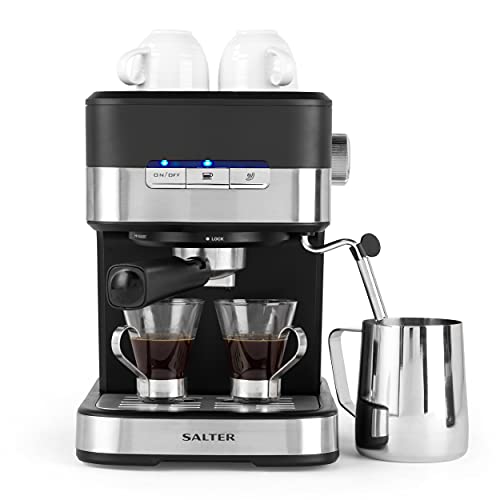How Does Machine Espresso Work?
Machine espresso utilizes precise pressure and mind-blowing filter technology to create the coffee we love. How exactly does it work?
To make espresso, hot water is pushed under pressure through finely ground coffee. The process is similar to making drip coffee but the difference is in the pressure.
The Head of the Group

The group head is the portafilter that you place in the espresso maker when making it. It is responsible for dispersing water into the portafilter and then controlling the pressure of the extraction. There are a variety of types of group head, each with their unique advantages and drawbacks. italian espresso machine are specifically designed for stability of temperature while others are built to handle pre-infusion. Others are built to control the lever. Some include a combination like the E61. This is a very popular choice for baristas due to the fact that it has multiple benefits in one package.
As you can see in the photo above the head of the group is equipped with several notches. You can place your portafilter inside these notches, and then twist the head to secure it. There is also a rubber gasket which is located inside the notches to help create the seal when you insert your portafilter into the machine. The notches permit precise placement of your portafilter. This is crucial for an even extraction.
The group head not only lets you to put in your portafilter easily however, it also keeps the same temperature. This is accomplished by cycling hot water around the portafilter and through the brew-basket, making sure the temperature is always right to extract the coffee. This is crucial, since even a few degrees can be the difference between a excellent and great espresso.
The Pump
The motorized pumps used in rotary espresso machines provide the nine atmospheric bar pressure needed for espresso extraction. This is different from manual piston machines that use a lever. The pressure builds up by removing tap water from a reservoir, and pumping it through a heat exchanger prior to it is shot through the ground coffee inside the group head.
Pumps tend to be more affordable and last longer than piston-driven machines. However, both types of machines may degrade because of frequent use and inadequate cleaning. They also create mechanical complexity, which can result in a high price tag on even the most basic models.
Some espresso machines employ steam pressure instead of a pump for brewing espresso. The downside is that the same boiler that produces steam also increases the temperature of water until it reaches boiling, which can lead to over-extraction. They also have to constantly rebuild their pressure in between cups. This requires energy and time.
A majority of espresso machines utilize either a vibration or rotary pump. A vibration model uses a vibrating disk to generate pressure, whereas the Rotary model pushes hot coffee through the ground at a fast speed. Both machines produce great espresso, but rotary machines are more quiet, durable and less likely to break.
The Boiler
The boiler is the component which heats the water to the optimal temperature for extraction. The steam produced will eventually reach the portafilter, which contains the espresso coffee grounds. It is then funneled into the cup. In this process, the steam creates pressure that pushes through the grounds of the coffee. This creates a layer crema on top. This is a hallmark of a great espresso.
There are three distinct types of espresso machines, each having different pumps and the temperature of the brew. There are a variety of ways to control the amount of brew, as well as the size of the cup that can be produced by the machine.
The first espresso machines were steam-types. The first espresso machines were steam types. This led to the coffee tasting bitter and burnt. The modern espresso machine was created by the Milanese producers Luigi Bezzerra & Desiderio Pavoni.
The most well-known espresso machine is a semiautomatic one with an electric pump. This is what people envision when they think of an espresso machine. Semi-automatic machines require you to grind and tamp the beans by yourself while the pump controls the flow of water and pressure. This is an excellent compromise between human touch and the mechanized quality.
The Filter
Typically, espresso machines use filters that separate the grounds of coffee as they move through the hot water. The filter is also a crucial part of the temperature control system, because it stops the machine from overheating.
It also aids in flavor, since a filter allows for a more prolonged bloom phase. This allows the beans to release their flavors, and allows for better extraction.
However it is crucial to remember that even a high-quality filter could result in a bad cup of coffee, since the quality of the beans and extraction are crucial.
It's here that the magic occurs. This is what makes espresso taste so delicious. The grouphead (also known as the brewhead) is where you place the portafilter, which is the thingy which you put the grounds of your coffee into while making espresso.
In a steam-driven espresso machine hot water is heated in an airtight tank to produce steam, which then pushes the hot water through the grounds at a high pressure. They are less expensive and are easier for the user to maintain than pumps-driven models. They are however limited for creating the ideal brewing conditions as they only operate with 1-1.5 bar of pressure. The ideal shot requires 9-10 bars.
In recent years, compressed air pump-driven espresso machines have been gaining popularity. They use an air compressor to force hot water through the grounds and are much more portable than electric steam-driven machines.
